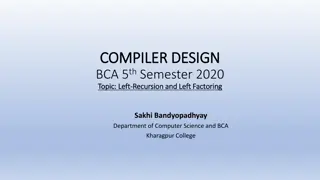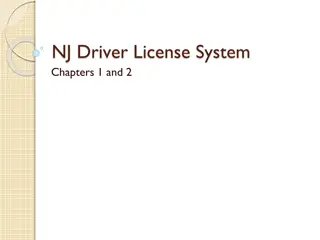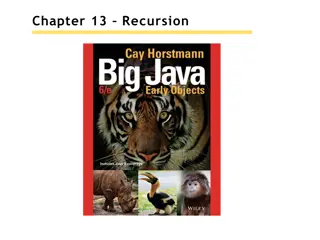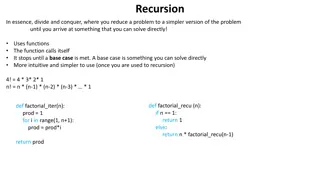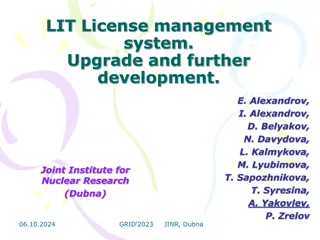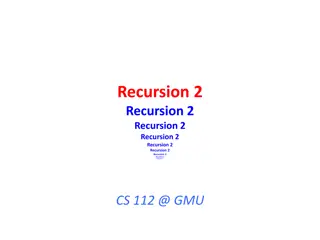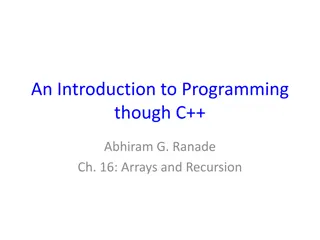Creative Commons License and Recursion Techniques in C++
The Creative Commons License for CS2 in C++ by Cynthia Bailey Lee and delve into recursion topics including backtracking techniques, Fibonacci sequences, and performance considerations. Engage with visual aids and resources linked in the content for a comprehensive understanding.
Download Presentation

Please find below an Image/Link to download the presentation.
The content on the website is provided AS IS for your information and personal use only. It may not be sold, licensed, or shared on other websites without obtaining consent from the author.If you encounter any issues during the download, it is possible that the publisher has removed the file from their server.
You are allowed to download the files provided on this website for personal or commercial use, subject to the condition that they are used lawfully. All files are the property of their respective owners.
The content on the website is provided AS IS for your information and personal use only. It may not be sold, licensed, or shared on other websites without obtaining consent from the author.
E N D
Presentation Transcript
Creative Commons License CS2 in C++ Peer Instruction Materials by Cynthia Bailey Lee is licensed under a Creative Commons Attribution-NonCommercial- ShareAlike 4.0 International License. Permissions beyond the scope of this license may be available at http://peerinstruction4cs.org. CS106X Programming Abstractions in C++ Cynthia Bailey Lee
2 Today s Topics: Recursion! 1. Backtracking recursion technique Periodic Table Speller 2. Fibonacci Is recursion good or bad for performance?
Backtracking Periodic table speller
http://commons.wikimedia.org/wiki/File:Periodic_Table_Armtuk3.svghttp://commons.wikimedia.org/wiki/File:Periodic_Table_Armtuk3.svg This file is licensed under the Creative Commons Attribution-Share Alike 3.0 Unported license.
Fibonacci This image is licensed under the Creative Commons Attribution-Share Alike 3.0 Unported license. http://commons.wikimedia.org/wiki/File:Golden_spiral_in_rectangles.png
Fibonacci f(0) = 0 f(1) = 1 For all n > 1: f(n) = f(n-1) + f(n-2) These files are, respectively: public domain (hurricane) and licensed under the Creative Commons Attribution 2.0 Generic license (fibonacci and fern.
Fibonacci F(0) = 0 F(1) = 1 F(n) = F(n-1) + F(n-2) for all n > 1 Work is duplicated throughout the call tree F(2) is calculated 3 separate times when calculating F(5)! 15 function calls in total for F(5)! Image is in the public domain. http://commons.wikimedia.org/wiki/File:Fibonacci_call_tree_5.gif
Fibonacci F(2) is calculated 3 separate times when calculating F(5)! How many times would we calculate Fib(2) while calculating Fib(6)? See if you can just read it off the chart above. A. 4 times B. 5 times C. 6 times D. Other/none/more Image is in the public domain. http://commons.wikimedia.org/wiki/File:Fibonacci_call_tree_5.gif
Fibonacci # of calls to fib(2) N fib(N) 2 1 1 3 2 1 4 3 2 5 5 3 6 8 7 13 8 21 9 34 10 55 Image is in the public domain. http://commons.wikimedia.org/wiki/File:Fibonacci_call_tree_5.gif
Efficiency of nave Fibonacci implementation When we added 1 to the input to Fibonacci, the number of times we had to calculate a given subroutine nearly doubled (~1.6 times*) Ouch! Can we predict how much time it will take to compute for arbitrary input n? * This number is called the Golden Ratio in math cool!
Efficiency of nave Fibonacci implementation Can we predict how much time it will take to compute for arbitrary input n? Each time we add 1 to the input, the time increases by a factor of 1.6 For input n, we multiply the baseline time by 1.6 n times:
Efficiency of nave Fibonacci implementation Can we predict how much time it will take to compute for arbitrary input n? Each time we add 1 to the input, the time increases by a factor of 1.6 For input n, we multiply the baseline time by 1.6 n times: b * 1.6 * 1.6 * 1.6 * * 1.6 n times
Efficiency of nave Fibonacci implementation Can we predict how much time it will take to compute for arbitrary input n? Each time we add 1 to the input, the time increases by a factor of 1.6 For input n, we multiply the baseline time by 1.6 n times: b * 1.6 * 1.6 * 1.6 * * 1.6 = b * 1.6n n times
Efficiency of nave Fibonacci implementation Can we predict how much time it will take to compute for arbitrary input n? Each time we add 1 to the input, the time increases by a factor of 1.6 For input n, we multiply the baseline time by 1.6 n times: b * 1.6 * 1.6 * 1.6 * * 1.6 = b * 1.6n = exponential category n times We don t really care what b is exactly (different on every machine anyway), so we just normalize by saying b = 1 time unit (i.e. we remove b)
Aside: recursion isnt always this bad Memory Recursive code long factorial ( int n ) { cout << n << endl; if (n==1) return 1; return n*factorial(n 1); } main() 10 0 mymethod() x: xfac: factorial() n:10 Roughly how much time does factorial take, as a function of the input n? It s better, just b * n = n Heap 0
Fibonacci Assume we have to calculate each unique function call once, but never again We remember the answer from the first time How many rectangles remain in the above chart for n=5? A. 3 B. 5 C. 7 D. 9 E. Other/none/more than one Image is in the public domain. http://commons.wikimedia.org/wiki/File:Fibonacci_call_tree_5.gif
New rule: Assume we have to calculate each unique function call once, but never again We remember the answer from the first time For some integer n>2, what is the largest number of function calls that can be triggered by the calculation of F(n) in this new remember system? A. Approx. log(n) B. Approx. n C. Approx. n2 D. Approx. 2n E. Other/none/more
Memo-ization Take notes ( memos ) as you go For Fibonacci, we will have answers for F(i) for all i 0 <= i <= n, so a simple array or Vector can store intermediate results: results[i] stores Fib(i) Map could also be a good choice: results[obj] stores RecursiveFunction(obj) For functions with two integer inputs a,b, you can keep memos in a Grid: results[a][b] stores RecursiveFunction(a,b)





